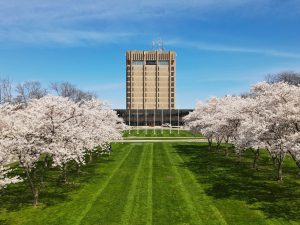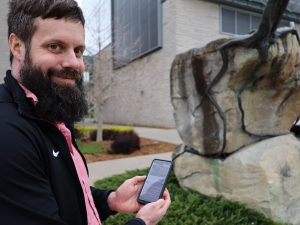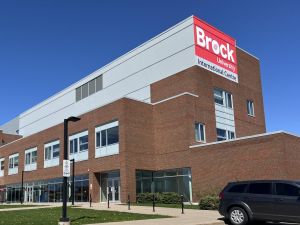 Tactile walking indicators, which alert visually impaired people to areas of vehicle traffic, were installed this week in the sidewalk along University Road East.
Tactile walking indicators, which alert visually impaired people to areas of vehicle traffic, were installed this week in the sidewalk along University Road East.The ongoing campaign to improve accessibility at Brock has been in evidence this summer, including walkway reconstruction and curb-cutting projects to make exterior pedestrian routes safer and more barrier-free.
Taking advantage of quieter pedestrian flows during the off-term months, numerous campus sidewalks have been upgraded as workers install textured ground plates — known as tactile walking surface indicators — that help people with visual impairment know when they are approaching street crossings and other vehicle routes.
This summer’s work is typical of upgrades the University has been undertaking for several years in order to improve accessibility and meet or surpass legislated standards, including the Accessibility for Ontarians with Disabilities Act.
“Each year since 2006, Brock budgets for works to improve accessibility,” said Paul Smeltzer, Interim Director of Campus Planning and Project Management. “To guide this work, Brock developed the Facility Accessibility Design Standards (FADS) for use in the design of facility upgrades and new facilities.”
Besides incorporating accessibility design into all new capital projects, Smetlzer said Facilities Management staff are also mindful of opportunities whenever normal maintenance upgrades are being planned, such as replacing stairs and ramps with infrastructure that is compliant and barrier-free.
Other projects in recent years include upgrading fire safety warning equipment, expanding the use of power openers and proximity detection equipment at main doorways, and renovating more washrooms to comply with the Ontario Building Code and Brock FADS standards. Given the number of washrooms on campus, this project will take several years to complete.
Smeltzer said a priority in the coming year will be improving service counters to remove barriers to service. Service counters at different locations around campus have been inventoried, and projects are being scheduled for 2017 and 2018.
Chris Lytle, Brock’s AODA Coordinator, said removing barriers has been legislated for all Ontario organizations or institutions to ensure that people can make use of environments that would otherwise be inaccessible.
“By using recommendations we’ve heard from the Brock Community in the Human Rights Task Force Report, we have the ability to implement specific strategies that are inclusive,” said Lytle. “This represents the practical application of human rights principles, to help us create an environment that is dignifying and respectful of people’s diversity.”








